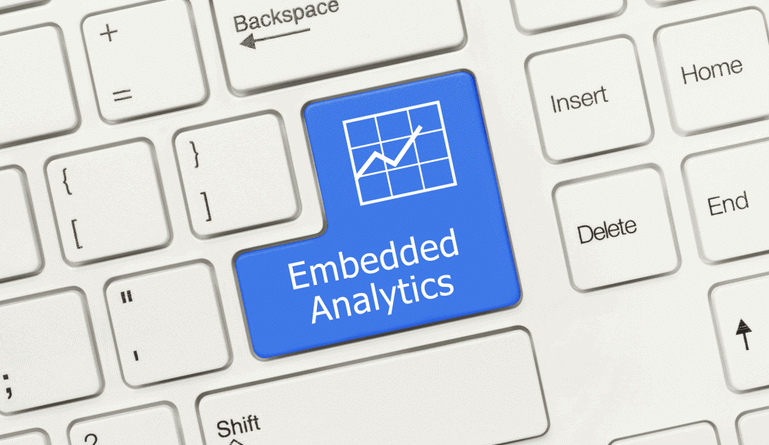Implementing embedded analytics into your company’s software applications can generate incredible benefits for your product or service. Embedded analytics can maximize user engagement and provide revenue streams that help to decrease client churn and increase business opportunities.
What is Embedded Analytics?
Embedded analytics involves the process of integrating data visualizations and analytical capabilities into a separate software application. Embedded analytics can be described as a window through which the final user gathers insights into the data that is stored within a specific software application.
Embedded Analytics Maturity Model
Embedded analytics aims to combine insight and action in the same area by deeply integrating analytics more and more into the business model and processes.
An application can launch at any period during the embedded analytics maturity model and progress with time. It has been discovered that Inline Analytics is the most accepted type of embedding today, while Infused Analytics is the point which is continually getting popular the most. As we will examine subsequently, the intensive integration of analytics in applications is linked to enhancing user experience, differentiating products, and maximizing end user adoption.
How to deploy embedded analytics
It is possible to incorporate embedded analytics by developing your individual solution or buying an appropriate business intelligence tool. In either case, it is necessary to maintain control and agility so as to achieve premium user experiences.
Developing an embedded analytics system can work for businesses that have high budget and technical resources for building and maintenance. However, it a better economic choice for some other businesses to purchase a business intelligence tool. Whichever solution you decide on should maintain current analytics capabilities and at the same time giving you control over the outlook and feel of the application to your users.
Examples of embedded analytics
By embedding analytics into your present business applications, reporting becomes simplified across your company. The application of embedded analytics in an organization’s customer-centered product will assist the business in getting to market quickly with freshly developed product or value differentiation.
Below, we have enumerated three scenarios of how organizations are maximizing market competitiveness, good decision-making, and customer satisfaction, all thanks to embedded analytics.
1. Embedded analytics quickly meets customer needs
An insurance software company was resolved to develop a better business intelligence tool that will better serve its casualty and property insurance clients. In order to launch the product ahead of market competition, they opted for a white label analytics method. The swift, flexible solution smoothly integrated with their existing product base, scaled with clients requirements, and offered real-time data analysis.
2. Embedded analytics streamlines data-driven decision-making
A particular leading healthcare tech company set two goals: analyze a huge collection of data securely and enable their over 10,000 pharmacy customers to easily derive useful insights from the analysed data. Developed on top of the company’s own technological applications, their solution introduced a highly effective analytics tool that provides data visualization for crucial operational data.
3. Embedded analytics provides an edge in competitive markets
A firm that specializes in assisting brands interact with their mobile audience had two things on their wish list for a data system: provide customers with valuable data at scale and offer those customers’ users with data to maximize user experience, campaigns, and messaging. Thanks to their implementation of embedded analytics, they quickly hit the market on time and achieved both important goals.
Benefits of embedded analytics
Primarily, embedded analytics enables an organization to deliver data to their clients and staff in the precise manner they want within the typical workflow setting. Some of the incredible benefits implementing embedded analytics into your existing product are:
-
Getting ahead of market competition
By embedding analytics, you can transform data from your product into meaningful information. Providing this information to clients directly in your product facilitates product stickiness anf adoption.
The absence of modern analytics embedding within your product to generate beneficial immune, will put you at a disadvantage in sustainable market competition. Users are expectant of analytics on everything. There is an all-time increase in the amount of data that is generated and businesses seek to leverage on the importance of insights hidden in the software platforms they buy through analytics.
Thus, when you embed the proper innovative analytics application, your end users are enabled to capitalize on modern technology so as to quickly get to the core of data insights. By choosing to embed an analytics application that is innovation-focused, your organization will always be updated with the newest technological innovations available to competitors and your client base. Consequently, this will give you a sustainable boost ahead of your competitors.
In another sense, embedded analytics will also increase your ability to enter the market quickly. You are bound to experience development and deployment challenge, delays, and setbacks, if you develop your own analytics capabilities. The longer it takes for you to enter market, the more challenging it will be for you to generate income from analytics. However, when you have a good embedded analytics partner, it becomes easy for you to launch into the market quickly. It is pertinent to expound that you’ll be engaged in business partnership with the analytics provide, since you’re only embedding their software into your application. Hence, choose your analytics provide wisely!
-
It helps to generate newer revenue sources
By embedding analytics, you can increase your streams of revenue from new value-oriented applications, premium offers, or monthly subscriptions. As a result of the massive value provided to your users via modern embedded analytics, the opportunity to increase revenue sources and upsell them becomes open to you. In itself, the analytics model can generate an extra income stream.
Alternatively, you can, for example, add dashboards and embedded reports as features in your platform and save programmed insights as a plus which your sales department can later upsell to customers.
-
Ability to retain additional customers
You can maximize your customer satisfaction levels and optimize user experience and retention when you embed analytics in parts of your products.
-
Enhancing client experience
With embedded analytics, you can enhance the experiences of your users with your platforms. This is because embedded analytics offers seamless delivery of data within the familiar workflows and product. Embedding a modern business intelligence model allows you to provide more capabilities that can revolutionize the way your users operate your application. They will be empowered to code their own festurew into their dashboards.
For instance, they can get instant, programmed insights without the manual process of data discovery. Collaboration over data is possible and they can share insights in a regulated system. What’s more is that modern embedded analytics further adds flexible design options and improved UI to the enhanced customer experience.
-
Increase in cost effectiveness
Embedded analytics is comparatively more cost-efficient than the cost of developing an embedded analytics solution from the beginning and maintaining it as time passes.
-
It enables businesses to dedicate resources on the uplift of their core products
Embedding analytics and business intelligence instead of developing it yourself also serves to release your developer resources so as to concentrate on your major offering. Analytics is not the end of your plan. Integrating the latest features and modern technologies will help you and your clients to achieve an ever-improving product and experience.
This is definitely not a process you would focus resources on if it isn’t vital to your core product.
Business Intelligence vs. Embedded Analytics
Business intelligence is a collection of independent systems – such as people, processes, and technologies – that collect data from various sources, arrange the data for processing, and then provides reporting and evaluation about that data from a core perspective. Business intelligence is best utilized for enhancing management-level decisions that need extremely aggregated views of info from across an entire organization, function, or department. These systems are particularly developed for individuals whose primary objective is to execute data analysis.
On the other hand, embedded analytics is an aggregate of capabilities that are closely integrated into current applications – such as a company’s information portals, financial systems, ERP, and/or CRM – which facilitate additional analytic capability, context or awareness to aid decision-making associated with different tasks. These tasks may need data gotten from various aggregated views or systems; however the result is beyond a centralized perspective of information. It is tactical information to aid an action or decision in the context in which that action or decision occurs.
In all, although traditional business intelligence has its position, the fact that business process applications and business intelligence applications are completely different in relation to their interfaces, makes it mandatory for users to switch from one application to another so as to get insights and act. Rather, embedded analytics integrates intelligence into the application we use every day in order to enhance the analytics experience and increase the productivity of users through a combination of insight and action in one application.
Final Thoughts
In all, the integration of embedded analytics enables enterprise users to access Business Intelligence tools without hassles while executing their daily talk tasks. As a result of this real-time access, your business can enjoy better informed and efficient decision making.
It’s high time you embraced embedded analytics within your business so you can capitalize on its several functionalities including mobile reports, interactive and static reports, benchmarking, visual workflows, self-service analytics, data visualization tools, and of course, dashboards.





